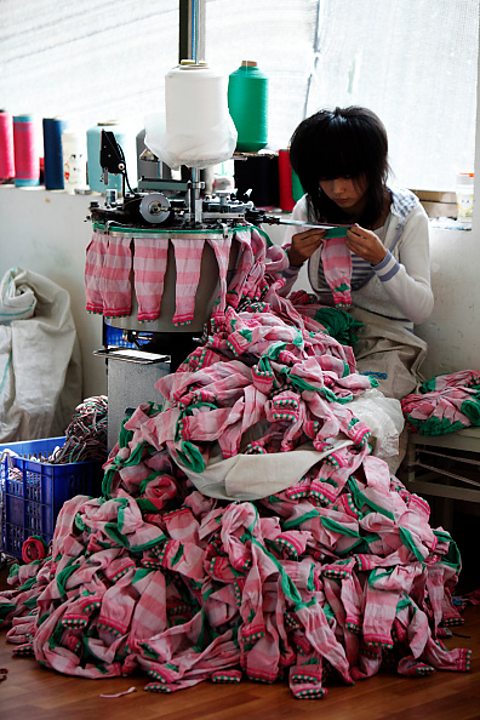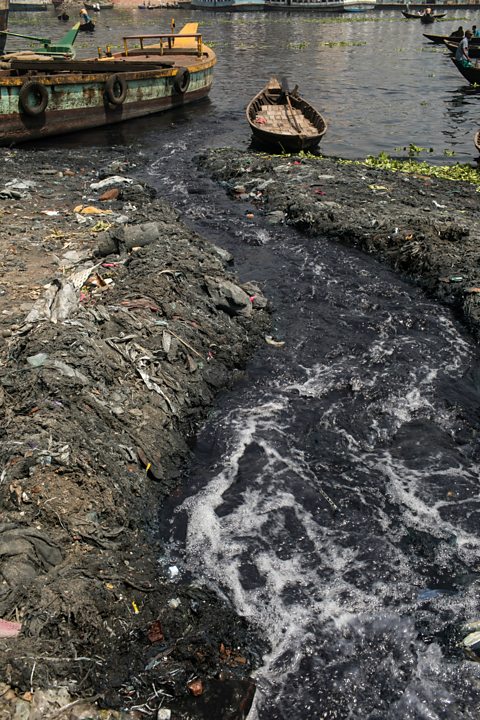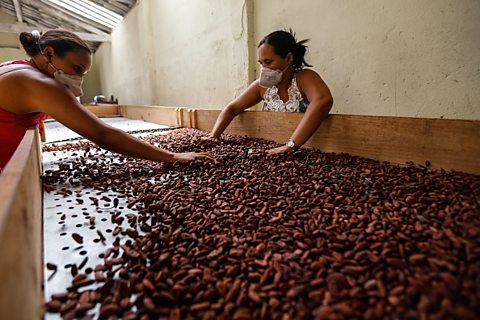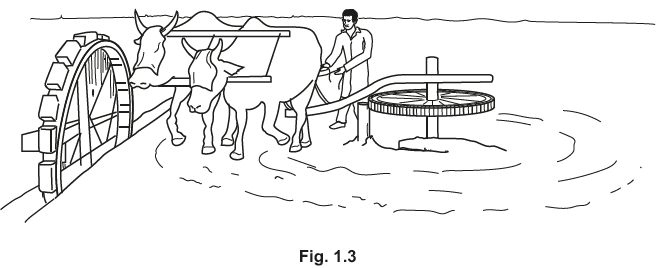summer 2023
1 (a) (i) Study Fig. 1.1, a map showing southern Pakistan and surrounding countries.
On Fig. 1.1 label the following: Afghanistan, India, Iran. You should write the name in the
correct location on the map. [3]
(ii) Add a dot and the letter K onto Fig. 1.1 to show the location of Karachi. [1]
(iii) Using Fig. 1.1 only, what is the approximate length of Pakistan’s coastline? Circle the
correct answer.
500 km 1000 km 1500 km [1]
1000 km
1 @ 1 mark
(iv) Name the rivers labelled X and Y on Fig. 1.1.
X: River Hub (Hab)
Y: River Ravi
2 @ 1 mark
(b) Suggest four ways in which rivers are important to Pakistan.
source of water/create reservoirs (domestic use/people to drink)
to provide a source of food/fish (to eat)
for transport (people/goods)
to provide nutrients/alluvium to the soil/flood plain/mangroves
for farming/agriculture/irrigation (of fields/crops)
for livestock/cattle/buffalo to drink/bathe/cool down
fish farming/commercial fishing/aquaculture
named manufacturing industry e.g. cement/textiles
for cooling in power stations/industry
habitat for wildlife/biodiversity/ecosystems
afforestation projects
to produce hydel/hydroelectric power/electricity
to add to scenic beauty to the area (for tourism)
for leisure activities/named example e.g.
boating/swimming/photography/fishing
for employment in a named industry e.g. fisherman/farmer
4 @ 1 mark
(d) Water is a valuable resource for the continued sustainable development of Pakistan. Read
the following two views about providing water:
Which view do you agree with more? Give reasons to support your answer and refer to
examples you have studied. You should consider view A and view B in your answer.
Content Guide
Agree with view A because:
untreated sewage/industrial effluent makes water unusable
dumping of waste in rivers is not strictly regulated
regular flooding causes fresh water supply to be contaminated
removing pollution from water is expensive and reduces the money available for water provision infrastructure
etc.
Disagree with view A because:
water pollution can be easily solved/prevented by imposing laws and fines on industries/companies who pollute the water
there are more serious threats to Pakistan’s water supply such as climate change e.g. increased risk of drought/flooding
a bigger threat is from neighbouring countries limiting the water supply from the headwaters
etc.
Agree with view B because:
rising temperatures increase evaporation from reservoirs so more of them are needed
global warming is melting glaciers in the mountains, more dams are needed to store water in reservoirs
Pakistan needs more water storage capacity to hold heavy rainfall e.g. in monsoon season, so water can be utilised
more reservoirs could alleviate future drought conditions if available supply was stored
more small dams across the country could aid in crop irrigation
it would be very expensive to build more dams/money is needed for other sectors.
etc.
Disagree with view B because:
there are enough dams already, those under construction need to be completed
existing dams are not all in the places where need is greatest therefore they have limited use
silting of reservoirs causes lower capacity making them less worthwhile
water conservation is a better solution than building more dams
conflicts over how water is used is a bigger threat
etc.
Examples: could include named dam/pollutant/settlement/river etc. but not named diseases.
winter 2023
(b) (i) Barrages have been built on many rivers. Name two barrages in Pakistan.
Balloki / Chashma / Ghazi Brotha / Guddu / Islam / Jinnah / Kotri / Khanki / Marala / Mohammadwala / Panjnad / Qadirabad / Rasul / Sinhnai / Sulemanki / Sukkur / Trimmu / Taunsa
2 @ 1 mark
(ii) Suggest how barrages can be useful to farmers.
- can be built on low/flat land/plains/near to farming areas
- regulate/control the flow of water in a river/keep river levels stable
- provide a reliable/constant supply of water
- help to prevent/control flooding
- gates are opened to let water into the river
- gates are closed to hold water back
- help with irrigation/in watering crops/direct water for irrigation/water can be diverted to perennial canals/provide water for livestock
3 @ 1 mark
winter 2022
(c) (i) Study Fig. 2.2, a pie chart showing the percentage share of Pakistan’s total irrigated
area by method of irrigation.
Complete Fig. 2.2 to show the percentages of Pakistan’s total irrigated area which are
irrigated by tubewells and by wells and other. Use the information below and the key.
Complete Fig. 2.2 to show the percentages of Pakistan’s total irrigated area which are irrigated by tubewells and by wells and other. Use the information below and the key.
Point accurately plotted and line drawn
Shading completed accurately using the key
Note: sections can be plotted in either order. 1 mark for line drawn at 80% or at 97%/1 mark for shading both sections accurately.
2 @ 1 mark
(ii) Explain two ways in which a karez irrigation system is operated to grow dates and
vegetables in a desert oasis. You should develop your answer.
- it is usually owned by a group of people in the village (rather than an individual); they share responsibility for its operation/share the water/share the costs of building/maintenance
- a (mother) well is dug down to the watertable/ground water; to access water underground/(using gravity) a tunnel brings water to the surface
- the tunnel is dug/starts from the base of a hill or mountain; this allows water to be transported from underground to dry areas where it is needed
- a tunnel/narrow underground canal; minimises evaporation (in the hot desert climate)
- the tunnel can run for a long distance/<10 kms/emerges at ground level; water is then taken to/used to irrigate/water the crops/fields (of dates and vegetables)
- where the tunnel reaches the surface/emerges trees are planted; this provides shade/reduces evaporation
- the karez is dotted with vertical shafts; this allows for cleaning/repairs to prevent blockages in the tunnels (and if completed regularly the karez can last for a century or longer)
Note: 1 mark for simple point and a further mark for the development of the point. 1 mark for second simple point and a further mark for development of the second point.
Note: Max. 2 marks if no development.
2 @ 2 marks
(iii) Suggest two disadvantages of using the karez system of irrigation.
- (traditional skilled) labour is needed to dig/maintain the tunnels/not many people with this knowledge/skill
- digging/boring/maintenance takes a lot of workers/time/is hard manual work/is dangerous work/requires machinery
- is expensive to build/lining the tunnels with (pvc/plastic) pipes is expensive
- machinery used to bore/dig causes air pollution/harmful gases
- owned by a co-operative/many owners/different percentage shares/can cause conflict/disagreements over sharing/not enough to go around
- water flowing through a karez cannot be stopped/water can be wasted/it is inefficient/tunnels can leak/water is absorbed into the ground/supplies too much water/can spoil crops
- have to use the water as soon as it flows (any time of day)
- need frequent maintenance/repairs/cleaning
- water is drying up/use of tubewells has lowered the water table/wells and tunnels must be dug deeper
- water is not (always) taken directly to the crops/(often) has to be transported to the crops/only irrigates a small area
- only feasible in specific geological landscapes
2 @ 1 mark
(d) To what extent can agricultural practices and water management be improved to prevent
waterlogging and salinity? Give reasons to support your judgement and refer to examples
you have studied. You should consider different points of view in your answer.
Content guide
It is possible to improve agricultural practices and water management to prevent waterlogging and salinity by:
- leaving parts of the land fallow – preventative measure
- building more dams/reservoirs to store more water
- lining/temporary closure of canals to reduce water leakages
- installing tubewells to flush the salt out of the soil/so flow of water for irrigation can be controlled
- planting eucalyptus trees to take in excess water when land is badly waterlogged
- digging surface/sub-surface drains
- removing salts by adding gypsum/by reducing fertiliser use
- Salinity Control and Reclamation Projects (SCARP)
- government legislation, e.g. water quotas
- cultivating salt tolerant crops
- using high-yielding varieties which require less irrigation
- using saline land for livestock farming
It is not possible to improve agricultural practices and water management to prevent waterlogging and salinity due to:
- cost/time taken for farmers to maintain canals/tunnels
- lack of investment in methods
- replacing traditional methods with tubewells lowers the water table and provides water for fewer farmers
- literacy/education levels may mean some farmers continue to over-irrigate
- SCARP projects date from 1958 and large public tubewells are deteriorating/reaching end of their life
- lack of access to/cannot afford high yielding varieties
- traditional irrigation systems are communally owned, change requires agreement/may generate disagreement
summer 2021
2 (a) (i) Study Fig. 2.1 showing a blank divided bar graph.
Complete Fig. 2.1 to show the percentage share of each source of surface water in
Pakistan. Use the information in the key. [5]
- each correct division showing percentage share of each source of surface
water = 1 mark – max 2 marks;
- each correct labelling or shading of each source of surface water = 1 mark
– max 3 marks.
Note: Any order accepted.
5 @ 1 mark
(ii) State three ways water is obtained for domestic purposes in Pakistan.
- directly from rivers/glaciers/lakes/pond;
- from wells/groundwater/from aquifers;
- via pipelines/water tankers/from reservoirs/taps;
- collecting rainwater (in tanks on the roof);
- using desalination.
3 @ 1 mark
(b) (i) Explain how water is used in two different secondary industries in Pakistan. You should
develop your answer.
- thermal power stations; to produce steam to move the turbines;
- mineral water industry; for bottling water this is the only input;
- iron and steel industry; to cool the furnace;
- HEP stations; pressure of water from a height or steep slope to move the
turbines;
- pharmaceutical industry; in the manufacture of drips, syrups, injections
etc;
- tanning industry; for washing/dyeing etc;
- food processing/beverages; for preparing
juices/squashes/syrups/beverages etc;
- chemical industry; for manufacturing acids/bleach/other solutions etc;
- textile industry; for washing/bleaching/ blueing/dyeing/printing etc;
- cement industry;
Etc.
Note: One mark for identification of appropriate idea and a further mark for
development.
Note: Max. 2 marks if no development.
2 @ 2 marks
(ii) Define ‘irrigation’.
It is the artificial supply of water to the land.
1 @ 1 mark
(iii) Name and describe one type of conventional irrigation system used in Pakistan.
- shaduf; water is drawn from a well, river or canal by a bucket.
- charsa; animal power is used to pull water from the well.
- Persian wheel; powered by a bullock which turns a wheel with a series of
pots attached to raise the water from well and tip it into the channels that
lead to the field.
- karez; horizontal underground canal in the foothills and brings the
underground water to the surface where it can be used.
- inundation canals; long canals taken off rivers. They fill when the river is
high enough and when it is in flood.
- diversion canal; a narrow version of an inundation canal and are often
used in steep areas so that they can take water to small terraced fields.
- tank irrigation; mud banks are constructed across small streams to make
a small reservoir to collect water in the rainy season.
Note: One mark for named technique and one mark for description.
2 @ 1 mark
(c) Outline two advantages and two disadvantages of using irrigation on small-scale subsistence
farms.
Advantages:
- can produce higher yields;
- extends farming seasons/can cultivate all year round;
- more land used for cultivation/can cultivate marginal land;
- can control the amount of water used;
- can grow a wider range of crops;
- can use over a wide area;
- saves time;
- more reliable than rainfall;
- can be cheap to install e.g. Persian wheel;
Etc.
Disadvantages:
- cost of installation/maintenance;
- difficult to build;
- inundation canals only flow during rainy periods or when glacial/snow
melt enters the rivers;
- waterlogging of soil;
- can increase salinity of soil;
- can cause siltation of barrages;
- unlined canals lead to seepage;
Etc.
Note: advantages = max 2 marks, disadvantages = max 2 marks
4 @ 1 mark
(d) The United Nations has predicted that Pakistan may become a ‘water scarce’ country by 2025.
To what extent can effective management of its water supply help Pakistan to avoid becoming
a ‘water scarce’ country in the future? Give reasons to support your judgement and refer to
examples you have studied. You should consider different points of view in your answer.
Content Guide
Answers are likely to refer to:
Effective management of the water supply may help because:
- Pakistan has enough water but it is not evenly spread throughout the
country;
- much water is lost through existing irrigation systems using traditional
methods;
- water is polluted through industrial and domestic waste/limited
environmental regulation;
- Pakistan needs to educate the people further about conserving
water/reusing grey water;
Etc.
Effective management of the water supply may not help because:
- population growth is leading to water scarcity and this should be tackled
first;
- Pakistan is suffering the consequences of climate change and this is an
international issue that requires multi-national agreements;
- the Indus Water Treaty causes many issues and needs to be updated;
Etc.
winter 2020
(ii) Study Fig. 1.3, a diagram showing a type of lift irrigation.
Describe how water is obtained for irrigation using this method.
- Persian wheel;
- animals are used to turn/moves a wheel;
- the animals are blindfolded;
- turns a horizontal/smaller wheel;
- attached/geared to a vertical/larger wheel;
- buckets or pots attached to the wheel;
- the pots raise water from the well;
- pots spill contents into the channel to fields/irrigate field.
4 @ 1 mark
(iii) List two ways the livestock shown in Fig. 1.2 can be used other than as draught power
for irrigation.
- ploughing/threshing/harvesting;
- pulling carts;
- carrying heavy loads/raw materials/people/transport;
- for meat/milk/skin/hides/dung/or other product.
2 @ 1 mark
(iii) What is waterlogging? Tick (3) one correct answer from the list below:
The water table rises to the surface.
1 @ 1 mark
winter 2019
2 (a) Study Fig. 2.1, a map showing the major rivers of Pakistan.
(i) Name rivers V, W, X and Y.
V = Indus
W= Jhelum
X = Chenab
Y = Ravi
4 @ 1 mark
(ii) Name dam Z shown on Fig. 2.1.
Z= Mangla Dam
1 @ 1 mark
(b) (i) Name two examples of barrages.
- Amandarra
- Balochi
- Chasma
- Guddu
- Islam
- Jinnah
- Kotri
- Kurrangarhi
- Marala
- Panjnad
- Qadirabad
- Rasul
- Siddha
- Sukkur
- Sulaimanka
- Taunsa
- Trimma
2 @ 1 mark
(ii) State the differences between barrages and dams.
- Dams store water / barrages control flow of water;
- Barrages can supply little / small amounts / no electricity (dams are
major suppliers of hydel power);
- Silting is a problem for dams (but not barrages);
- Maintenance cost is lower for barrages (more expensive for dams);
- Construction and or maintenance time is quicker for barrages (longer
for dams);
- Construction cost is lower for barrages (more expensive for dams);
- Fewer or no people have to be evacuated for barrages;
- Barrages have less environmental impact than dams;
- Barrages can be built on flat land (dams require steep slopes);
- Dams have multiple uses whereas barrages do not;
- Dams provide water for a larger area than barrages;
- Barrage to deviate channel to an area where there is no river;
- Do not need to excavate a large area for barrages.
4 @ 1 mark
(iii) Suggest four problems caused by siltation. [4]
- Reducing water supply / less water available / water becomes silty /
pipes blocked / reduces capacity of reservoir / less water stored;
- Blocking the flow of water / blocks canals or rivers / chokes or blocks
irrigation canals or pipes / water cannot get through / floods may occur;
- Weakens foundations of dams / have to be emptied or strengthened /
flow of flood water is hampered and can damage dam / damage to
turbines or machinery;
- Not enough water for irrigation / industry / domestic use;
- Reduces water available for hydel power / generation of hydel power
stopped;
- Encourages growth of algae / eutrophication.
(c) Explain why rivers are important to Pakistan. You should develop your answer.
- Scenic beauty; for tourism / picnic / leisure (dev);
- Provides water; especially to areas where rainfall is low/named;
examples / sustains life or drinking water (dev);
- Helps to generate hydel power / electricity; which reduces power
shortages / reduces need to import coal or oil / reduces need to use
fossil fuels (dev) / one of main sources of electricity;
- Adds alluvium to soil; so, improves the fertility of the soil / aids crop
growth (dev);
- For fishing industry / subsistence fishing; provides income or food
supply to local areas / people (dev);
- Provides water for domestic use / in the home; named examples, e.g.
cooking / cleaning (dev);
- Provides water for industries; named examples, e.g. cement, brick
making, cotton (dev);
- Provides water for irrigation / agriculture / farming; used to irrigate /
water crops / feed livestock / or named examples, e.g. wheat / cotton /
sugar cane (dev);
- Transport; for trade / avoid using roads or rail / access to ports (dev);
Etc.
Note: One mark for identification of appropriate idea and a further mark for
development (in parentheses).
Note: Max. 2 marks if no development.
2 @ 2 marks
(d) Read the following two views about providing solutions to the challenges of water supply in
Pakistan:
Which view do you agree with more? Give reasons to support your answer and refer to
examples you have studied. You should consider View A and View B in your answer.
Content Guide
Answers are likely to refer to:
Small dams
- Cheaper to construct;
- Less technical expertise needed;
- Can be built more quickly;
- Minimal disruption to people and environment;
Etc.
Large dams
- More people will benefit;
- Can produce HEP which is good for developing the country;
- Provides employment opportunities;
- A bigger area is utilized;
Etc.
summer 2017
4 (a) (i) Study Fig. 5, which shows a diagram of the karez system of irrigation.
Choose three terms from the list below and use them to label the diagram in three of the
spaces provided.
maintenance shaft aquifer canal tunnel water table [3]
Any three of (L to R):
canal, aquifer, water table, maintenance shaft, tunnel
3 @ 1 mark
(ii) Give an example of a barrage in Pakistan and name the river it is on.
(iii) State why barrages are needed in Pakistan.
- Irrigation/release water for irrigation;
- Provide water supply to perennial canals/link canals;
- Flood control;
- Flow of water controlled;
- To stimulate economic development/industry/settlement.
2 @ 1 mark
(b) (i) Describe two ways in which the atmosphere in Pakistan can be polluted.
- Smoke/fumes/gases/named gases/harmful gases from
factories/tanneries/industries/chimneys/power stations;
- Smoke/fumes/gases/named gases from vehicle exhausts;
- Burning fossil fuels;
- Clearing forests by burning;
- Release of gases/methane from livestock/rice/paddy fields/landfill;
- Burning domestic rubbish/incineration;
- Air pollution/dust from mineral extraction/mining/ quarrying.
2 @ 1 mark
(ii) Explain how the use of chemical fertilisers on farms damages the natural environment.
You should develop your answer.
- Cause pollution of rivers/watercourses (runoff from farmland
containing chemicals washes into them);
- Pollution of groundwater (from infiltration eventually entering rivers,
polluting them);
- Eutrophication in rivers (nitrates/phosphates cause algal blooms
which increase CO2/reduce O2)/(killing fish/aquatic animals/destroy
aquatic life);
- Causes ecosystem to be unbalanced (through loss/ extinction of
species) (through disruption to food chains/ food webs);
- Overuse of fertilisers (damages soil/makes soil infertile/
poisons/damages natural vegetation).
ETC.
Note: One mark for identification of appropriate idea and a further mark for
development (in parentheses).
Note: Max 2 marks if no development.
2 @ 2 marks
(c) Study Fig. 6, which shows water use by sector in Pakistan in 2008.
(i) A Which sector used least water?
B How much water was used by the irrigation/livestock sector?
A Domestic
B 94% (allow 93–95%)
2 @ 1 mark
(ii) Name a type of industry that uses large amounts of water.
One of:
Beverages/soft drinks/juice industry/dyeing/tanning/printing/
iron/steel/nuclear/textiles/chemical/pharmaceutical/hydel/
HEP/paper/tourism/leisure/inland fish farms.
1 @ 1 mark
(iii) About 60% of irrigation water is lost before it reaches crops. Give three reasons why
irrigation water is lost in this way.
- Seepage from beds of canals/absorbed into the soil/land/no canal
lining;
- Evaporation/evapotranspiration from surface of
canals/tanks/flooded land;
- Excessive runoff of water immediately into streams/rivers;
- Theft of water/theft from canals;
- Water drawn up by vegetation on side of canal;
- Mismanagement.
3 @ 1 mark
(d) Read the following two views about water shortages in Pakistan:
Which view do you agree with more? Give reasons to support your answer and refer to
examples you have studied. You should consider both View A and View B in your answer.
Content Guide:
Answers are likely to refer to:
For infrastructure
- Prevents loss of water downstream into sea
- Collects rainfall/snowmelt
- Reservoirs feed perennial canals
- Can store large amounts of water
Against infrastructure
- Source of conflict between countries and provinces
- Social issues
- Loss of fresh water at Indus Delta
- Water intrusion into Sindh
- High initial investment
- Little use in Balochistan where rivers dry up
- Mismanagement by provincial/national government
- Siltation occurs
For water saving
- Planting trees
- Lining canals
- Careful monitoring/regulation of amount of water used
- Better forms of water storage in homes
- Water meters in homes/industries
Against water saving
- Long time scale required to educate sufficient number of people
- Resistance to education
- Water a valuable raw material in industry
- Growing population with increasing demand for drinking water
- Development goal to increase availability of water
ETC.
summer 2016
4 (a) (i) Study Fig. 7 which is a diagram of an HEP (Hydel) power station.
A. On the diagram place an arrow or arrows to indicate the direction of movement of
water through the power station.
B. Choose two terms from the list below and use them to label the diagram in two of
the spaces provided.
outflow turbine reservoir dam [3]
A: Arrow(s) drawn downwards through channel
B: From L to R: reservoir dam turbine outflow
NB: ‘water intake’ top left space not used
(ii) Name one multi-purpose dam in Pakistan. [1]
Tarbela/Mangla/Warsak
(iii) Give two uses for a dam such as the one you named in (ii). [2]
HEP/electricity [generation]
Irrigation
Water supply / stores water [for industrial/domestic use]
Controlling floods
Recreation/named recreational use/tourist attraction
Fishing















































